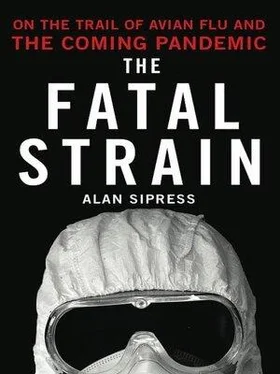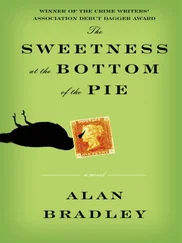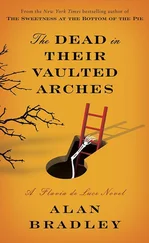Prasert received me in his sixth-floor office at Mahidol University’s microbiology department, where he had established the virology program decades earlier. Siriraj Hospital, home to the department, is a teeming complex of white-and-cream towers rising on the west bank of the Chao Phraya River, which winds through the heart of the Thai capital. The dark waters below bustle with low-slung ferries shuttling commuters and shoppers between the shores, carnival-colored long-tail boats popular with sightseers, and the occasional tugboat dragging a sand barge slowly downriver. On the opposing bank shimmer the fairy-tale pagodas and gold steeples of the Grand Palace, the Temple of the Emerald Buddha, and the other signature sites of royal Bangkok. Prasert’s office was cramped but well air-conditioned, a relief from the hospital’s steamy corridors. Several bouquets of silk-and-plastic flowers brightened the room. As Prasert’s assistants brought us coffee, he slipped on the white lab coat of a man still very much involved in scientific inquiry and sank into the cushions of a purple sofa. Then, after offering a few observations about the merits of Thai coffee beans, he began to recount how he had forced his government to come clean.
In November 2003, Thai poultry farmers had begun to complain about a disease devastating their flocks. Their chickens at first seemed depressed and lost their appetites. The hens stopped laying eggs. The birds would soon start to wheeze and cough as the sickness ravaged their lungs. Some would develop diarrhea. Many would stagger around as their brains began to hemorrhage, melting into a bloody cranial mush. They would die suddenly, often overnight, and by the thousands. This disease was killing with a speed almost never seen in Thailand or anywhere on Earth.
Thai agriculture officials investigated and, suppressing the truth, reassured farmers it was nothing serious, just a minor outbreak of fowl cholera complicated by bronchitis. The country’s deputy agriculture minister and livestock chief would both later blame the spiraling death toll on the weather, saying that an abrupt seasonal change had left chickens in a weakened state that made them vulnerable to catching these two infections in tandem. There was no reason to panic. There was certainly no reason, the agriculture officials said disingenuously, for anyone to doubt the quality of poultry raised in Thailand, which at the time was the world’s fourth-largest chicken exporter, annually shipping $1.3 billion worth overseas.
Prasert heard the initial reports and had no reason to disbelieve them. But he was intrigued. Though he had spent years studying infectious diseases, from dengue fever to HIV-AIDS, fowl cholera was entirely new for him. “I just wanted to see about it,” he explained. So in the predawn hours of a December morning, Prasert headed for the wet market that sprawls across more than a dozen acres beside the Bangkok Noi railway station. There, across from the creaky gray train carriages ferrying farmers from the countryside, Thais continue to shop as they have for generations. Prasert ventured into the warren of crowded aisles, slightly stooped, stepping carefully along floors slick with water and mud, past mounds of pineapples, mangos, hairy ramb utan, and lavender dragon fruit, past chili peppers and curry power heaped high in plastic baskets, past pig heads lined up along white tile countertops and catfish slithering in their trays. Even before he reached the chicken mongers, he could hear the repeated thump of their cleavers as they hacked the birds into wings and legs, feet and ankles, liver and intestines. He asked around until he located several peddlers whose families raised poultry in Nakhon Sawan province, about a hundred miles north. Prasert had heard it was at the center of the fowl cholera outbreak.
“They said they didn’t believe it,” he recalled. “They said it wasn’t like fowl cholera. If they have some chickens that are sick with that, they give them tetracycline, and they get better. But these chickens, by the next morning, they’re all dead. So they thought there was something more than that.”
Prasert was unsure what to make of this skepticism and filed away their dissent. “I didn’t pay much attention to that then,” he said. But within two weeks, when his friends came to him with apologies instead of eggs, he remembered what the farmers of Nakhon Sawan had said.
His ears now attuned to reports of ailing chickens, Prasert was starting to hear about a bird flu outbreak in southern China. Though Chinese agriculture officials would not disclose the spreading infection for nearly two more months, in late January 2004, the virus had in fact been circulating there for years. This was no secret to Chinese farmers, veterinarians, and researchers, and the rumor soon reached Prasert. He surmised that the flu virus afflicting Chinese poultry was now making chickens sick in Thailand. He suspected that migratory birds had spread the disease from China. But he still needed proof.
With Thai livestock officials continuing to hide evidence of bird flu, Prasert turned to two colleagues at the Ministry of Public Health. Together they plotted to smuggle poultry samples from the countryside into Bangkok for testing. Since agriculture officials had barred them from visiting chicken farms, Prasert and his colleagues called a farmer in Chachoengsao province, home to the county’s largest concentration of chickens, and recruited him as an accomplice. They arranged for him to wrap two dead chickens in newspaper and then leave them at the edge of his property like innocent rubbish. The pair of health ministry officials would drive out to the province to collect the contraband carcasses.
When the officials arrived back in the capital, they called Prasert. “We’ve got them,” they reported. “What should we do now?”
“Bring them here,” he instructed.
As a medical facility, Siriraj Hospital was not authorized to test animal samples, just those from humans. But Prasert was sure that veterinary labs would refuse to run tests of the dead chickens, fearing government reprisal, or would decline to tell him the results. “We had to do it ourselves. It was a must,” he said. Prasert immediately turned the samples over to lab researchers at his hospital, who began secretly analyzing them for both influenza and fowl cholera.
The proof he was seeking came later that evening, “December 19, twenty-hundred hours,” Prasert recounted, flashing a broad smile. The researchers brought him lab results demonstrating that the birds were infected with influenza. The tests were not precise enough to determine whether the virus was specifically H5N1, which had surfaced in Hong Kong in 1997 and had been circulating in China ever since. Siriraj Hospital did not have the right chemical reagents to tease this information out of animal samples. But Prasert was now sure that something more than fowl cholera and bronchitis was troubling Thailand’s chickens. And if it was bird flu, he was convinced it had to be H5N1. That meant that the people of Thailand and beyond were in peril. They had no natural defense against this novel strain of flu.
Prasert placed an urgent call to senior officials at the health ministry. “I have evidence that this is avian flu,” he notified them. He told them they had to be vigilant. He urged them to prepare for a medical emergency. But he was rebuffed. “For agricultural production, we have nothing to do with that,” one senior health officer responded curtly.
Prasert was aghast. “This is a public health concern,” he scolded, “and I will not close my mouth. I will talk even louder. I’m retired already and no one employs me. It’s not like I’m a government official.”
Prasert was not alone in suspecting the worst. Inside Thailand’s health ministry itself, infectious-disease specialists were already speculating that the strange sickness decimating the country’s chickens was flu. Officials in the ministry’s disease-control department later told me they had heard rumors as early as November 2003 about flu outbreaks among birds in China and Vietnam. So the ministry sent out letters across Thailand alerting doctors in the provinces to be on guard. The public health surveillance system, which Thailand put in place months earlier in response to the SARS epidemic, was urgently revamped to monitor for bird flu. But health officials remained mute in public. They issued no advice on how to avoid the virus, no warning against contact with sick birds. There was no public guidance about how to recognize the disease if you caught it and what to do if you did. No effort was made to import and stockpile Tamiflu, which was considered the main remedy for the virus.
Читать дальше











